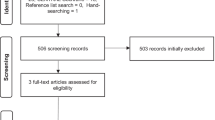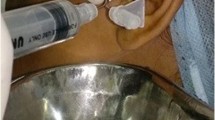Abstract
Objectives
This systematic review assessed the clinical question: ‘Does ultrasonography (USG)-guided arthrocentesis provide better outcomes than conventional arthrocentesis in patients with temporomandibular disorder (TMD)?’
Materials and methods
The review was conducted based on the Preferred Reporting Items for Systematic Reviews and Meta-Analyses (PRISMA) statement. An initial search was performed on electronic databases—including Medline, PubMed, and Cochrane Library—followed by manual and reference searches until the date September 27, 2019. The articles selected were evaluated for study and patient characteristics, arthrocentesis procedure details, and treatment outcomes (post-operative pain, maximum mouth opening (MMO), procedure time, and attempts of needle positioning). Risk of bias was assessed with the Cochrane Consumers and Communication Review Group’s data extraction template and Critical Appraisal Skills Programme (CASP).
Results
Out of the 325 initially identified articles, four studies with 144 patients were included in the final qualitative analysis. No significant differences were found in pain reduction and improved MMO between sample groups receiving conventional arthrocentesis and USG-guided arthrocentesis. Needle positioning attempts and procedural times were conflicting between the two groups.
Conclusions
This systematic review found that the outcomes of USG-guided arthrocentesis were not superior to conventional arthrocentesis. Conflicting data was found in the attempts of needle positioning and procedural time. Standardized treatment protocols and data from well-designed USG-guided arthrocentesis randomized clinical trials were lacking.
Clinical relevance
Arthrocentesis with or without USG guidance are both effective for treating patients with TMD to reduce pain and to improve MMO. USG-guided arthrocentesis was not found to be superior to conventional arthrocentesis.

Similar content being viewed by others
References
Kundu H, Basavaraj P, Kote S, Singla A, Singh S (2013) Assessment of TMJ disorders using ultrasonography as a diagnostic tool: a review. J Clin Diagn Res 7(12):3116–3120. https://doi.org/10.7860/JCDR/2013/6678.3874
Research NIoDaC (2013) Data and statistics - facial pain. National Institute of Dental and Craniofacial Research. http://www.nidcr.nih.gov/DataStatistics/FindDataByTopic/FacialPain/. Accessed 10 Sept 2019
Sharma S, Gupta DS, Pal US, Jurel SK (2011) Etiological factors of temporomandibular joint disorders. Natl J Maxillofac Surg 2(2):116–119. https://doi.org/10.4103/0975-5950.94463
Rodriguez-Lopez MJ, Fernandez-Baena M, Aldaya-Valverde C (2015) Management of pain secondary to temporomandibular joint syndrome with peripheral nerve stimulation. Pain Physician 18(2):E229–E236
Ramirez LM, Ballesteros LE, Sandoval GP (2008) Topical review: temporomandibular disorders in an integral otic symptom model. Int J Audiol 47(4):215–227. https://doi.org/10.1080/14992020701843137
Ismail F, Eisenburger M, Lange K, Schneller T, Schwabe L, Strempel J, Stiesch M (2016) Identification of psychological comorbidity in TMD-patients. Cranio 34(3):182–187. https://doi.org/10.1179/2151090315Y.0000000008
Dahlstrom L, Carlsson GE (2010) Temporomandibular disorders and oral health-related quality of life. A systematic review. Acta Odontol Scand 68(2):80–85. https://doi.org/10.3109/00016350903431118
White RD (2001) Arthroscopic lysis and lavage as the preferred treatment for internal derangement of the temporomandibular joint. J Oral Maxillofac Surg 59(3):313–316. https://doi.org/10.1053/joms.2001.21002
Nitzan DW, Dolwick MF, Martinez GA (1991) Temporomandibular joint arthrocentesis: a simplified treatment for severe, limited mouth opening. Journal of oral and maxillofacial surgery : official journal of the American Association of Oral and Maxillofacial Surgeons 49(11):1163–1170. https://doi.org/10.1016/0278-2391(91)90409-f
Monje-Gil F, Nitzan D, Gonzalez-Garcia R (2012) Temporomandibular joint arthrocentesis. Review of the literature. Medicina oral, patologia oral y cirugia bucal 17(4):e575–e581. https://doi.org/10.4317/medoral.17670
Laskin DM (2018) Arthroscopy versus arthrocentesis for treating internal derangements of the temporomandibular joint. Oral and maxillofacial surgery clinics of North America 30(3):325–328. https://doi.org/10.1016/j.coms.2018.04.008
Senturk MF, Yazici T, Gulsen U (2018) Techniques and modifications for TMJ arthrocentesis: a literature review. Cranio 36(5):332–340. https://doi.org/10.1080/08869634.2017.1340226
McDicken WN, Anderson T (2011) CHAPTER 1 - basic physics of medical ultrasound. In: Allan PL, Baxter GM, Weston MJ (eds) Clinical ultrasound, 3rd edn. Churchill Livingstone, Edinburgh, pp 3–15. https://doi.org/10.1016/B978-0-7020-3131-1.00001-8
Nabeih YB, Speculand B (1991) Ultrasonography as a diagnostic aid in temporomandibular joint dysfunction: a preliminary investigation. Int J Oral Maxillofac Surg 20(3):182–186. https://doi.org/10.1016/S0901-5027(05)80013-X
LA Moher D, Tetzlaff J, Altman DG, The PRISMA Group (2009) Preferred reporting items for systematic reviews and meta-analyses: the PRISMA statement. PLoS Med 6(7):e1000097. https://doi.org/10.1371/journal.pmed.1000097
University LT (2018) Cochrane consumers and communication author’s guide to protocol processes figshare. Journal contribution. doi: https://doi.org/10.26181/5b57ce9b316d2
Cha YH, O J, Park JK, Yang HM, Kim SH (2019) Ultrasound-guided versus blind temporomandibular joint injections: a pilot cadaveric evaluation. Int J Oral Maxillofac Surg 48(4):540–545. https://doi.org/10.1016/j.ijom.2018.09.002
Champs B, Corre P, Hamel A, Laffite CD, Le Goff B (2019) US-guided temporomandibular joint injection: validation of an in-plane longitudinal approach. J Stomatol Oral Maxillofac Surg 120(1):67–70. https://doi.org/10.1016/j.jormas.2018.10.008
Chakraborty A, Datta T, Lingegowda D, Khemka R (2016) Ultrasound-guided temporomandibular joint injection for chronic posthemimandibulectomy jaw pain. A A Case Rep 7(10):203–206. https://doi.org/10.1213/xaa.0000000000000384
Resnick CM, Vakilian PM, Kaban LB, Peacock ZS (2017) Is intra-articular steroid injection to the temporomandibular joint for juvenile idiopathic arthritis more effective and efficient when performed with image guidance? J Oral Maxillofac Surg 75(4):694–700. https://doi.org/10.1016/j.joms.2016.09.045
Dayisoylu EH, Cifci E, Uckan S (2013) Ultrasound-guided arthrocentesis of the temporomandibular joint. Br J Oral Maxillofac Surg 51(7):667–668. https://doi.org/10.1016/j.bjoms.2013.05.144
Habibi S, Ellis J, Strike H, Ramanan AV (2012) Safety and efficacy of US-guided CS injection into temporomandibular joints in children with active JIA. Rheumatology (Oxford) 51(5):874–877. https://doi.org/10.1093/rheumatology/ker441
Parra DA, Chan M, Krishnamurthy G, Spiegel L, Amaral JG, Temple MJ, John PR, Connolly BL (2010) Use and accuracy of US guidance for image-guided injections of the temporomandibular joints in children with arthritis. Pediatr Radiol 40(9):1498–1504. https://doi.org/10.1007/s00247-010-1581-2
Senturk MF, Yildirim D, Bilgir E (2019) Evaluation of ultrasonography guidance for single-puncture temporomandibular joint arthrocentesis: a randomized clinical study. Cranio 37(3):181–187. https://doi.org/10.1080/08869634.2017.1407095
Antony PG, Sebastian A, Annapoorani D, Varghese KG, Mohan S, Jayakumar N, Dominic S, John B (2019) Comparison of clinical outcomes of treatment of dysfunction of the temporomandibular joint between conventional and ultrasound-guided arthrocentesis. Br J Oral Maxillofac Surg 57(1):62–66. https://doi.org/10.1016/j.bjoms.2018.11.007
Bhargava D, Thomas S, Pawar P, Jain M, Pathak P (2019) Ultrasound-guided arthrocentesis using single-puncture, double-lumen, single-barrel needle for patients with temporomandibular joint acute closed lock internal derangement. Oral Maxillofac Surg 23(2):159–165. https://doi.org/10.1007/s10006-019-00753-6
Sivri MB, Ozkan Y, Pekiner FN, Gocmen G (2016) Comparison of ultrasound-guided and conventional arthrocentesis of the temporomandibular joint. Br J Oral Maxillofac Surg 54(6):677–681. https://doi.org/10.1016/j.bjoms.2016.04.004
Manfredini D, Tognini F, Melchiorre D, Zampa V, Bosco M (2003) Ultrasound assessment of increased capsular width as a predictor of temporomandibular joint effusion. Dentomaxillofac Radiol 32(6):359–364. https://doi.org/10.1259/dmfr/25091144
Jank S, Emshoff R, Norer B, Missmann M, Nicasi A, Strobl H, Gassner R, Rudisch A, Bodner G (2005) Diagnostic quality of dynamic high-resolution ultrasonography of the TMJ--a pilot study. Int J Oral Maxillofac Surg 34(2):132–137. https://doi.org/10.1016/j.ijom.2004.03.014
de Mello Junior CF, de Cassio SO, Guimarães Filho HA (2011) Sonographic evaluation of temporomandibular joint internal disorders. Radiol Bras 44(6):326–334
Jank S, Rudisch A, Bodner G, Brandlmaier I, Gerhard S, Emshoff R (2001) High-resolution ultrasonography of the TMJ: helpful diagnostic approach for patients with TMJ disorders ? J Craniomaxillofac Surg 29(6):366–371. https://doi.org/10.1054/jcms.2001.0252
Bas B, Yilmaz N, Gokce E, Akan H (2011) Diagnostic value of ultrasonography in temporomandibular disorders. J Oral Maxillofac Surg 69(5):1304–1310. https://doi.org/10.1016/j.joms.2010.07.012
Emshoff R, Bertram S, Rudisch A, Gassner R (1997) The diagnostic value of ultrasonography to determine the temporomandibular joint disk position. Oral Surg Oral Med Oral Pathol Oral Radiol Endod 84(6):688–696. https://doi.org/10.1016/s1079-2104(97)90374-7
Kaya K, Dulgeroglu D, Unsal-Delialioglu S, Babadag M, Tacal T, Barlak A, Ozel S (2010) Diagnostic value of ultrasonography in the evaluation of the temporomandibular joint anterior disc displacement. J Craniomaxillofac Surg 38(5):391–395. https://doi.org/10.1016/j.jcms.2009.10.017
Pumklin J (2018) A literature review of temporomandibular joint arthrocentesis: start to success. Journal of International Dental and Medical Research 11(2):486–490
Zardeneta G, Mukai H, Tiner B, VANSICKELS J, GRANT G, SCHMITZ J, MILAM S (1995) Positive correlation between TMJ pain and alpha-hemoglobin recovered by TMJ lavage. J Dent Res 74:172–172
Zardeneta G, Milam SB, Schmitz JP (1997) Elution of proteins by continuous temporomandibular joint arthrocentesis. J Oral Maxillofac Surg 55(7):709–716; discussion 716-707. https://doi.org/10.1016/s0278-2391(97)90583-8
Kaneyama K, Segami N, Nishimura M, Sato J, Fujimura K, Yoshimura H (2004) The ideal lavage volume for removing bradykinin, interleukin-6, and protein from the temporomandibular joint by arthrocentesis. J Oral Maxillofac Surg 62(6):657–661. https://doi.org/10.1016/j.joms.2003.08.031
Stoustrup P, Kristensen KD, Kuseler A, Pedersen TK, Herlin T (2015) Temporomandibular joint steroid injections in patients with juvenile idiopathic arthritis: an observational pilot study on the long-term effect on signs and symptoms. Pediatr Rheumatol Online J 13:62. https://doi.org/10.1186/s12969-015-0060-6
Antonarakis GS, Courvoisier DS, Hanquinet S, Dhouib A, Carlomagno R, Hofer M, Scolozzi P (2018) Benefit of temporomandibular joint lavage with intra-articular steroids versus lavage alone in the management of temporomandibular joint involvement in juvenile idiopathic arthritis. J Oral Maxillofac Surg 76(6):1200–1206. https://doi.org/10.1016/j.joms.2017.12.030
Singh RK, Pal US, Goyal P, Nischal A, Gurung TR, Daga D (2018) TMJ Arthrocentesis alone and in combination with duloxetine in temporomandibular joint pain. J Maxillofac Oral Surg 17(3):270–275. https://doi.org/10.1007/s12663-017-1037-4
Tatli U, Benlidayi ME, Ekren O, Salimov F (2017) Comparison of the effectiveness of three different treatment methods for temporomandibular joint disc displacement without reduction. Int J Oral Maxillofac Surg 46(5):603–609. https://doi.org/10.1016/j.ijom.2017.01.018
Li C, Zhang Y, Lv J, Shi Z (2012) Inferior or double joint spaces injection versus superior joint space injection for temporomandibular disorders: a systematic review and meta-analysis. J Oral Maxillofac Surg 70(1):37–44. https://doi.org/10.1016/j.joms.2011.04.009
Liu J, Mu H, Wang Z, Lan J, Zhang S, Long X, Zhang D (2015) Joint cavity injection combined with manual reduction and stabilization splint treatment of anterior disc displacement. Int J Clin Exp Med 8(4):5943–5948
Schulz KF, Altman DG, Moher D (2010) CONSORT 2010 statement: updated guidelines for reporting parallel group randomised trials. PLoS Med 7(3):e1000251. https://doi.org/10.1371/journal.pmed.1000251
Author information
Authors and Affiliations
Corresponding author
Ethics declarations
Ethical approval
Not required.
Patient consensus
Not required.
Conflict of interest
The authors declare that they have no conflicts of interest.
Additional information
Publisher’s note
Springer Nature remains neutral with regard to jurisdictional claims in published maps and institutional affiliations.
Rights and permissions
About this article
Cite this article
Leung, Y.Y., Wu, F.H.W. & Chan, H.H. Ultrasonography-guided arthrocentesis versus conventional arthrocentesis in treating internal derangement of temporomandibular joint: a systematic review. Clin Oral Invest 24, 3771–3780 (2020). https://doi.org/10.1007/s00784-020-03408-z
Received:
Accepted:
Published:
Issue Date:
DOI: https://doi.org/10.1007/s00784-020-03408-z




